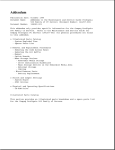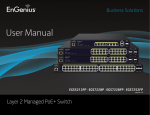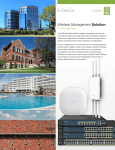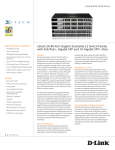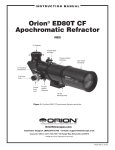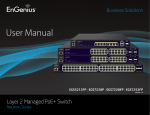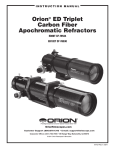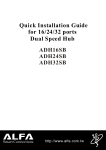Download EnGenius EGS7228FP Specifications
Transcript
EGS7228FP 24-Port Gigabit PoE+ Layer 2 Switch (370W) with 4 Dual-Speed SFP Key Features • Simple to use, manage, and deploy • A full-featured Layer 2 PoE+ Switch • • • • • • IEEE 802.3at/af PoE on its 24 Gigabit Ports with a total PoE budget of 370W (up to 30W per port) Includes 4 Dual-Speed SFP (fiber) uplink ports for integrating with an existing network or cascading to other Switches Up to 56 Gbps non-blocking switching capacity Easy to manage and configure via a Web-based Graphical User Interface (GUI) Cable Diagnostics Advanced Features: 802.1X, ACLs, IGMP Snooping, SNMPv1/v2/v3, RSTP, MSTP • Link Aggregation • Port Security • Command Line Interface (CLI) • Power conservation during off hours with EEE Standard • The EGS7228FP is a 24-Port (370W) Gigabit PoE+ Layer 2 Switch with 4 DualSpeed SFP ports for fiber uplinks. The EGS7228FP includes 24 Gigabit PoE (10/100/1000 Mbps) ports and four SFP (copper/hot-swappable small formfactor pluggable) Gigabit ports for optional fiber connectivity. Managing the wired portion of the network is easy using the Switch’s browser-based interface. The EGS7228FP is a full featured Gigabit Ethernet Switch with comprehensive Layer 2 switching capabilities. The EnGenius Layer 2 switch includes IGMP Snooping, MLD Snooping, Port Mirroring, Rapid Spanning Tree, Multiple Spanning Tree, Spanning Tree, VLAN group, Voice VLAN, ACL, 802.1X port security, SNMP v1/v2c/v3 and IEEE802.3ad Link Aggregation Control Protocol (LACP). Optional Redundant Power Supply boosts the available PoE budget to 740W The EGS7228FP provides 802.1Q VLAN support for improved convergence and bandwidth utilization. The Switch automates the process of setting up VoIP devices on a network. Voice VLAN offers clear quality and efficient transmission for all voice communications while also providing a means of securing each broadcast domain, segregating them from each other. VLANs can be configured to segment departmental resources and can be implemented on an SMB network help to restrict access to sensitive information from one department to another. The EGS7228FP supports IGMP Snooping, MLD Snooping, and VLAN for multicast applications. By passively snooping IGMP packets transferred between the Switch and the IP multicast host, registration information is recorded and sorted into multicast groups. The Switch can then intelligently forward traffic to only those ports that request multicast traffic. MLD Snooping enhances efficiency in selective distribution by forwarding IPv6 multicast data to receiving ports, rather than flooding all ports in a VLAN. IGMPv1—Defined in RFC 1112. An explicit join message is sent to the Switch, but a timeout is used to determine when hosts leave a group. IGMPv2—Defined in RFC 2236. Adds an explicit leave message to the join message so that the Switch can more easily determine when a group has no interested listeners on a LAN. IGMPv3—Defined in RFC 3376. Support for a single source of content for a multicast group. Priority queueing ensures high-priority traffic gets delivered efficiently, even during congestion from high traffic bursts. The ability to prioritize traffic ensures quality of latency-sensitive services and applications despite increasing traffic loads. For mission critical environments, the EGS7228FP supports 802.1D, 802.1w and 802.1s Spanning Tree Protocols (STP). STP allows users to configure the switch with a redundant backup bridge path, so transmission and reception of packets can be guaranteed in the event of any failed switch on the network. The Switch supports IEEE 802.1p QoS that automatically classifies and prioritizes compliant device traffic to ensure that time sensitive data such as VoIP is forwarded without delay. To help streamline networks, 802.1p Priority Tagging places a priority tag in a specified frame placing it in a priority queue once received and enabling it to be prioritized ahead of other frames. IEEE 802.1p enables administrators to assign and designate traffic priority. This process helps applications such as VoIP and video conferencing to be delivered clear and jitter-free. The EGS7228FP also supports 802.1X port-based authentication, so IT managers can authenticate clients via external RADIUS servers. In addition, the Access Control List (ACL) feature enhances network security and protects the network by screening traffic from unauthorized MAC or IP addresses. This high-performing switch also features a non-blocking wire-speed architecture with a 56 Gbps switching capacity for maximum data throughput. The IEEE 802.3x Flow Control function allows servers to directly connect to the switch for fast, reliable data transfer. Network maintenance features include Spanning Tree and Cable Diagnostics for easy troubleshooting. This EnGenius Layer 2 Switch is designed for easy network management and can quickly be added to an existing rack of other branded L2 and L3 switches. Configuration of the Switch is made through an intuitive and user-friendly Web interface for quick and easy management. The EnGenius L2 Switch also includes SNMP (v1, v2 and v3) to collect and track data to monitor network health, manage devices, and more easily enforce critical IT controls and policies. The Switch’s Link Layer Discovery Protocol (LLDP) feature allows it and other network devices connected to it to announce and display their identity and capabilities on the local network, which helps IT managers better manage, troubleshoot or correct issues that may arise on the network. The EGS7228FP is capable of conserving power without sacrificing operational performance. With the Energy Efficient Ethernet (EEE) standard, the network will automatically decrease its power usage when traffic is low with no setup required. The PoE Management feature lets IT managers control the PoE usage on each port so that unnecessary power consumption can be saved during off hours. The Switch can also detect the length of connected cables to automatically reduce power usage on shorter cable connections. With a total power budget of 370W for the EGS7228FP, customers can choose to plug in up to 24 802.3at/af IP-based devices. Power-over-Ethernet (PoE) optimizes the installation and power management of network devices such as wireless Access Points (APs), Voice over IP (VoIP) phones, and IP-based surveillance cameras. In addition, the EGS7228FP’s Power-over- Ethernet (IEEE 802.3at/af) capabilities reduce installation time and costs for many new network productivity devices. Free your wireless AP deployments and IP cameras from the restrictions of power outlet proximity using a standard Cat 5 cable. PoE+ IEEE 802.3at/af Support - Enables PoE devices like Access Points, Client Bridges, IP Cameras, VoIP telephones and others to be powered directly from the Switch over an Ethernet cable. - Up to 30W per port with a total PoE budget of 370W. Gigabit Wired Speed Utilizes Gigabit Ethernet standard speeds of up to 1000 Mbps for each port, making it ideal for media streaming and large file transfers throughout the network. 4 Dual-Speed SFP Ports Includes 4 SFP ports to support transceivers for fiber cabling for connectivity to offices, buildings, or other parts of the network that exceed the distance capability of regular Ethernet. Full-Featured Layer 2 Manageability The full-featured, managed Layer 2 Switch includes: VLAN, QoS, IGMP/MLD Snooping, STP/RSTP/MSTP, Link Aggregation Control Protocol (LACP), SNMP v1/v2c/v3, and more. VLAN and Voice VLAN Capabilities Provides 802.1Q VLAN support for improved convergence and bandwidth utilization and automates the process of setting up VoIP devices on a network. Voice VLAN guarantees clear quality and efficient transmission for all voice communications. Making the Network More Secure Supports 802.1X port-based authentication, so IT managers can authenticate clients via external RADIUS servers. In addition, the Access Control List (ACL) feature enhances network security and protects the network by screening traffic from unauthorized MAC or IP addresses. Optional Redundant Power Supply Allows an IT manager to extend the EGS7228FP’s PoE budget by 370W, extending the total PoE budget to 740W. Connect a RPS370 to the Switch to provide redundant power in case of primary power supply failure. The Switch’s Gigabit Ethernet ports support IEEE 802.3at/af PoE and can supply up to 30W per port for a total PoE budget of 370W. The 24 Gigabit ports provide seamless connectivity for devices and applications that require high speed network access and reduce bottlenecks that can interrupt communication. The Switch’s 4 SFP slots accept fiber transceivers for extending the wired network beyond the limitation of Ethernet cabling. This is especially useful for schools with satellite classrooms, for hotels and resorts, or other businesses with multiple building properties. The EGS7228FP includes bracketing hardware for mounting into a switch rack. For even more power, the RPS370 is a Redundant Power Supply which allows an IT manager to extend the EGS7228FP’s PoE budget by 370W, extending the total PoE budget to 740W. Users can connect a RPS370 to the Switch to provide redundant power in case of primary power supply failure. 2 Building 2 EGS7228FP Building 1 Fiber EGS7228FP Fiber LAN Mode LED LED Mode Selector LAN Mode LED Reset Button Building 3 Dual-Speed SFP Slots Link/Act LED (Per Copper Port) LAN Mode LED (Per Copper Port) Power LED Fault LED RJ45 Console Port Front PoE Max LED PoE Mode LED Link/Act LED (Per SFP Port) PoE Ethernet Ports Speed LED (Per SFP Port) Power Connector Rack Mount Hole 13.8” 1.7” Back 17.3” Side 3 Specifications Standards General Features BootP/DHCP Client Switching Capacity: 56Gbps Firmware Burn-Proof Forwarding Mode: Store and Forward 802.1X Port-based Access Control SDRAM: 256MB 802.1X Guest VLAN Flash Memory: 32MB Port Security Port Isolation Port Functions Storm Control 24 10/100/1000Mbps Ports Attack Prevention 4 100/1000Mbps SFP Slots Access Control List (ACL) 1 RJ45 Console Port SSH Server Telnet Server PoE Capability TFTP Client PoE Standard: supports IEEE 802.3af/at Web-based support PoE Capable Ports: Port 1-24 output up to 30W SNMP v1 support Total PoE Power Budget: 370 Watts SNMP v2c support SNMP v3 support LED Indicators TFTP upgrade Device Command Line Interface (CLI) Power LED Fault LED LAN Mode LED PoE Mode LED PoE Max LED SNTP RMONv1 SYSLOG Copper Ports LAN/PoE Mode Cable Diagnostics Link/Act MIB Support SFP Ports RFC1213 Speed, Link/Act RFC1493 Layer 2 Features 802.3ad Compatible Link Aggregation 802.1D Spanning Tree (STP) 802.1w Rapid Spanning Tree (RSTP) RFC1757 RFC2674 Environmental & Mechanical Temperature Range 802.1s Multiple Spanning Tree (MSTP) Operating: 32°F to 132°F / 0 to 50°C IGMP Snooping v1/v2/v3 Storage: -40 to 158°F / -40 to 70 ° C MLD Snooping IGMP Fast Leave Humidity Port Trunking 5 - 95% non-condensing Port Mirroring: One to one and many to one VLAN Group Package Contents Voice VLAN EGS7228FP Layer 2 Switch RJ45 Console Cable PoE Management Rack Mount Kit Power on/off per port Power Cord Power Feeding with Priority Quick Installation Guide Power Class Configuration User Defined Power Limit Queue CoS based on 802.1p priority CoS based on physical port CoS based on TOS CoS based on DSCP Weights & Measures EGS7228FP Device Weight: 10.46 lb. (4744 g) Width: 17.3” (440 mm) Length: 13.8” (310 mm) Height: 1.7” (44 mm) Warranty: 1 Year EnGenius Technologies | 1580 Scenic Ave. Costa Mesa, CA 92626 Features and specifications subject to change without notice. Trademarks and registered trademarks are the property of their respective owners. For United States of America: Copyright © 2014 EnGenius Technologies, Inc. All rights reserved. Version 2.0 - 06/13/14 Maximum data rates are based on IEEE 802.3.ab standards. Actual throughput and range may vary depending on distance between devices or traffic and bandwidth load in the network. Compliant with FCC - This equipment has been tested and found to comply with the limits for a Class A digital device, pursuant to Part 15 of the FCC Rules. These limits are designed to provide reasonable protection against harmful interference in a residential installation. This equipment generates, uses, and can radiate radio frequency energy and, if not installed and used in accordance with the instructions, may cause harmful interference to radio communications. Operation of this equipment in a residential area is likely to cause harmful interference in which case the user will be required to correct the interference at his/her own expense. .




